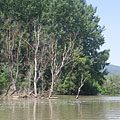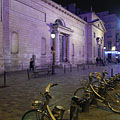(Optimalizované pro zařízení s malou obrazovkou)
Miscellaneous photos - Esztergom (Ostřihom), Maďarsko
Když klepnete:
Klikněte na obrázky!
-
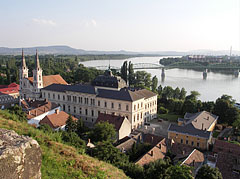
The twin-towered Roman Catholic Parish Church of St. Ignatius of Loyola (also known as the Watertown Church) and the Primate's Palace on the Danube bank, plus the Mária Valéria Bridge
Datum fotografie: 5. 7. 20062006
Vytvořil: Robert Németh
Model fotoaparátu: Konica Minolta Dimage A200
Esztergom (Ostřihom), Maďarsko
-
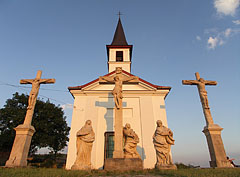
Calvary chapel on Szent Tamás Hill (Saint Thomas Becket of Canterbury Chapel or Pietà Chapel)
Datum fotografie: 5. 7. 20062006
Vytvořil: Robert Németh
Model fotoaparátu: Konica Minolta Dimage A200
Esztergom (Ostřihom), Maďarsko
-

Ister Fountain (in Hungarian "Ister-kút") with five women sculpture in the water
Created by Péter Párkányi-Raab in 2006
Datum fotografie: 9. 10. 20082008
Vytvořil: Robert Németh
Model fotoaparátu: Konica Minolta Dimage A200
Esztergom (Ostřihom), Maďarsko
-
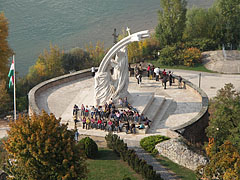
View from the cupola to the round bastion with the sculpture of Miklós Melocco, as well as to River Danube.
Datum fotografie: 9. 10. 20082008
Vytvořil: Robert Németh
Model fotoaparátu: Konica Minolta Dimage A200
Esztergom (Ostřihom), Maďarsko
-

The south side of the Szent Tamás Hill (literally "Saint Thomas Hill")
Datum fotografie: 9. 10. 20082008
Vytvořil: Robert Németh
Model fotoaparátu: Konica Minolta Dimage A200
Esztergom (Ostřihom), Maďarsko
-
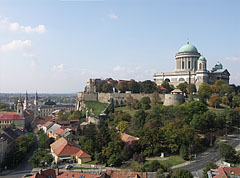
Castle of Esztergom and the Basilica on the Castle Hill
Datum fotografie: 9. 10. 20082008
Vytvořil: Robert Németh
Model fotoaparátu: Konica Minolta Dimage A200
Esztergom (Ostřihom), Maďarsko
-
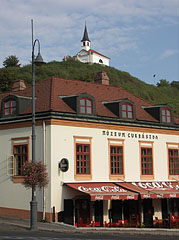
Moody pastry shop, farther the calvary chapel on Szent Tamás Hill
Datum fotografie: 9. 10. 20082008
Vytvořil: Robert Németh
Model fotoaparátu: Konica Minolta Dimage A200
Esztergom (Ostřihom), Maďarsko
-
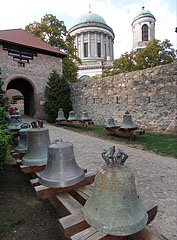
Exhibited bells in the castle, and farther the dome and the belltower of Esztergom Basilica can be seen.
Datum fotografie: 9. 10. 20082008
Vytvořil: Robert Németh
Model fotoaparátu: Konica Minolta Dimage A200
Esztergom (Ostřihom), Maďarsko
-
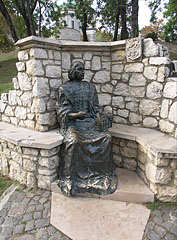
Seated bronze statue of Archbishop János Vitéz (1465-1472) on the side of the Castle Hill
Created by Zoltán Szentirmai in 1988
Datum fotografie: 9. 10. 20082008
Vytvořil: Robert Németh
Model fotoaparátu: Konica Minolta Dimage A200
Esztergom (Ostřihom), Maďarsko
-
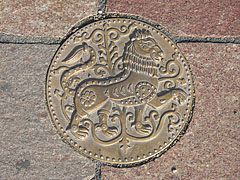
A circular bronze piece of art, a lion figure in the pavement
Datum fotografie: 9. 10. 20082008
Vytvořil: Robert Németh
Model fotoaparátu: Konica Minolta Dimage A200
Esztergom (Ostřihom), Maďarsko
-
Unique Holy Trinity column in front of the City Hall (Vak Bottyán Palace)
Created by György Kiss in 1900
Datum fotografie: 9. 10. 20082008
Vytvořil: Robert Németh
Model fotoaparátu: Konica Minolta Dimage A200
Esztergom (Ostřihom), Maďarsko
Unique Holy Trinity column in front of the City Hall (Vak Bottyán Palace) - Esztergom (Ostřihom), Maďarsko -
The way up on the South Western side of the Szent Tamás Hill or St. Thomas Hill
Built in 1938 by the plans of Dezső Várnai engineer, who was also the leader of the archeological excavations here.
Datum fotografie: 9. 10. 20082008
Vytvořil: Robert Németh
Model fotoaparátu: Konica Minolta Dimage A200
Esztergom (Ostřihom), Maďarsko
The way up on the South Western side of the Szent Tamás Hill or St. Thomas Hill - Esztergom (Ostřihom), Maďarsko -
"Béla IV King of Hungary and his family" bronze relief close to the Franciscan friary and secondary school
Created by János Nagy in 2000
Datum fotografie: 9. 10. 20082008
Vytvořil: Robert Németh
Model fotoaparátu: Konica Minolta Dimage A200
Esztergom (Ostřihom), Maďarsko
"Béla IV King of Hungary and his family" bronze relief close to the Franciscan friary and secondary school - Esztergom (Ostřihom), Maďarsko -
The former County Hall and Vice Palatine's palace, also known as the House of General András Török, the pale green two-storey baroque building was built around 1747
Datum fotografie: 9. 10. 20082008
Vytvořil: Robert Németh
Model fotoaparátu: Konica Minolta Dimage A200
Esztergom (Ostřihom), Maďarsko
The former County Hall and Vice Palatine's palace, also known as the House of General András Török, the pale green two-storey baroque building was built around 1747 - Esztergom (Ostřihom), Maďarsko -
The baroque stone balcony of the former County Hall, also known as the House of General Török (or General Török's House)
Datum fotografie: 9. 10. 20082008
Vytvořil: Robert Németh
Model fotoaparátu: Konica Minolta Dimage A200
Esztergom (Ostřihom), Maďarsko
The baroque stone balcony of the former County Hall, also known as the House of General Török (or General Török's House) - Esztergom (Ostřihom), Maďarsko -
Clock tower on the eastern wing of the Town Hall
This part of the building was built between 1778-1779 from the donation of Empress Maria Theresa, initially it was a high school.
Datum fotografie: 9. 10. 20082008
Vytvořil: Robert Németh
Model fotoaparátu: Konica Minolta Dimage A200
Esztergom (Ostřihom), Maďarsko
Clock tower on the eastern wing of the Town Hall - Esztergom (Ostřihom), Maďarsko -
The romantic style building on the right side of the picture is the Post Office, also known as the Müller House
Built in 1863, architect: János Prokopp
Datum fotografie: 9. 10. 20082008
Vytvořil: Robert Németh
Model fotoaparátu: Konica Minolta Dimage A200
Esztergom (Ostřihom), Maďarsko
The romantic style building on the right side of the picture is the Post Office, also known as the Müller House - Esztergom (Ostřihom), Maďarsko -
The arcaded baroque Vak Bottyán Palace is the Town Hall of Esztergom since 1723
The building as we can see today was completed in 1773.
Datum fotografie: 9. 10. 20082008
Vytvořil: Robert Németh
Model fotoaparátu: Konica Minolta Dimage A200
Esztergom (Ostřihom), Maďarsko
The arcaded baroque Vak Bottyán Palace is the Town Hall of Esztergom since 1723 - Esztergom (Ostřihom), Maďarsko -
The main square got this decorative pavement in 2006, when it was completely renovated
In the background it is the classical style Frey House from 1827, architect: József Schwarz
Datum fotografie: 9. 10. 20082008
Vytvořil: Robert Németh
Model fotoaparátu: Konica Minolta Dimage A200
Esztergom (Ostřihom), Maďarsko
The main square got this decorative pavement in 2006, when it was completely renovated - Esztergom (Ostřihom), Maďarsko -
The red painted Leffter House was rebuilt in 1996
The building got its name after the former owner, the Greek Leffter merchant family, who moved here in 1881.
Datum fotografie: 9. 10. 20082008
Vytvořil: Robert Németh
Model fotoaparátu: Konica Minolta Dimage A200
Esztergom (Ostřihom), Maďarsko
The red painted Leffter House was rebuilt in 1996 - Esztergom (Ostřihom), Maďarsko -
Black memorial stone from 2006 in the flooring of the square, referring to the year 972, the date when the town was founded
Datum fotografie: 9. 10. 20082008
Vytvořil: Robert Németh
Model fotoaparátu: Konica Minolta Dimage A200
Esztergom (Ostřihom), Maďarsko
Black memorial stone from 2006 in the flooring of the square, referring to the year 972, the date when the town was founded - Esztergom (Ostřihom), Maďarsko -
The "Ister Fountain" in the main square of the town
Datum fotografie: 9. 10. 20082008
Vytvořil: Robert Németh
Model fotoaparátu: Konica Minolta Dimage A200
Esztergom (Ostřihom), Maďarsko
The "Ister Fountain" in the main square of the town - Esztergom (Ostřihom), Maďarsko -
Ettore Café, confectionery and ice cream shop
Datum fotografie: 9. 10. 20082008
Vytvořil: Robert Németh
Model fotoaparátu: Konica Minolta Dimage A200
Esztergom (Ostřihom), Maďarsko
Ettore Café, confectionery and ice cream shop - Esztergom (Ostřihom), Maďarsko -
"Crowning St. Stephen of Hungary", large stone relief on the wall at the way up to the Szent Tamás Hill
Created by Károly Antal in 1938
Datum fotografie: 9. 10. 20082008
Vytvořil: Robert Németh
Model fotoaparátu: Konica Minolta Dimage A200
Esztergom (Ostřihom), Maďarsko
"Crowning St. Stephen of Hungary", large stone relief on the wall at the way up to the Szent Tamás Hill - Esztergom (Ostřihom), Maďarsko -
The Castle Hill with the wall remains of the 10th-century origin Castle of Esztergom
Datum fotografie: 9. 10. 20082008
Vytvořil: Robert Németh
Model fotoaparátu: Konica Minolta Dimage A200
Esztergom (Ostřihom), Maďarsko
The Castle Hill with the wall remains of the 10th-century origin Castle of Esztergom - Esztergom (Ostřihom), Maďarsko -
"Judas betrayed his master", scene on a station of the Szenttamás Calvary
Created by Andreas Schrott in 1781
Datum fotografie: 9. 10. 20082008
Vytvořil: Robert Németh
Model fotoaparátu: Konica Minolta Dimage A200
Esztergom (Ostřihom), Maďarsko
"Judas betrayed his master", scene on a station of the Szenttamás Calvary - Esztergom (Ostřihom), Maďarsko -
Calvary of Szenttamás, "Judas betrayed his master" station
Datum fotografie: 9. 10. 20082008
Vytvořil: Robert Németh
Model fotoaparátu: Konica Minolta Dimage A200
Esztergom (Ostřihom), Maďarsko
Calvary of Szenttamás, "Judas betrayed his master" station - Esztergom (Ostřihom), Maďarsko -
The first station of Szent Tamás Hill Calvary: "Scene on the Mount of Olives"
Datum fotografie: 9. 10. 20082008
Vytvořil: Robert Németh
Model fotoaparátu: Konica Minolta Dimage A200
Esztergom (Ostřihom), Maďarsko
The first station of Szent Tamás Hill Calvary: "Scene on the Mount of Olives" - Esztergom (Ostřihom), Maďarsko -
"Scene on the Mount of Olives", the first station of the Szenttamás Calvary
Created by Andreas Schrott in 1781
Datum fotografie: 9. 10. 20082008
Vytvořil: Robert Németh
Model fotoaparátu: Konica Minolta Dimage A200
Esztergom (Ostřihom), Maďarsko
"Scene on the Mount of Olives", the first station of the Szenttamás Calvary - Esztergom (Ostřihom), Maďarsko -
The view of the Calvary of Szenttamás from the Castle Hill
Datum fotografie: 9. 10. 20082008
Vytvořil: Robert Németh
Model fotoaparátu: Konica Minolta Dimage A200
Esztergom (Ostřihom), Maďarsko
The view of the Calvary of Szenttamás from the Castle Hill - Esztergom (Ostřihom), Maďarsko -
Abstract statue of a soldier at the drawbridge of the castle
Created by Tamás Vígh in 1979
Datum fotografie: 9. 10. 20082008
Vytvořil: Robert Németh
Model fotoaparátu: Konica Minolta Dimage A200
Esztergom (Ostřihom), Maďarsko
Abstract statue of a soldier at the drawbridge of the castle - Esztergom (Ostřihom), Maďarsko -
The circular bastion of the Esztergom Castle fortress
Datum fotografie: 9. 10. 20082008
Vytvořil: Robert Németh
Model fotoaparátu: Konica Minolta Dimage A200
Esztergom (Ostřihom), Maďarsko
The circular bastion of the Esztergom Castle fortress - Esztergom (Ostřihom), Maďarsko -
A gate of the Esztergom Castle with a wooden bridge (probably once it was a drawbridge)
Datum fotografie: 9. 10. 20082008
Vytvořil: Robert Németh
Model fotoaparátu: Konica Minolta Dimage A200
Esztergom (Ostřihom), Maďarsko
A gate of the Esztergom Castle with a wooden bridge (probably once it was a drawbridge) - Esztergom (Ostřihom), Maďarsko -
The baroque style Calvary of Szenttamás, on the Szent Tamás Hill (or St. Thomas Hill)
Datum fotografie: 9. 10. 20082008
Vytvořil: Robert Németh
Model fotoaparátu: Konica Minolta Dimage A200
Esztergom (Ostřihom), Maďarsko
The baroque style Calvary of Szenttamás, on the Szent Tamás Hill (or St. Thomas Hill) - Esztergom (Ostřihom), Maďarsko -
Outlook from the rondella (round bastion) of the castle to Mária Valéria Bridge (a Bridge to Párkány) over River Danube
On the left it is Saint Ignatius of Loyola Roman Catholic parish church.
Datum fotografie: 5. 7. 20062006
Vytvořil: Robert Németh
Model fotoaparátu: Konica Minolta Dimage A200
Esztergom (Ostřihom), Maďarsko
Outlook from the rondella (round bastion) of the castle to Mária Valéria Bridge (a Bridge to Párkány) over River Danube - Esztergom (Ostřihom), Maďarsko -
Confectionery and Cafe
Datum fotografie: 5. 7. 20062006
Vytvořil: Robert Németh
Model fotoaparátu: Konica Minolta Dimage A200
Esztergom (Ostřihom), Maďarsko
Confectionery and Cafe - Esztergom (Ostřihom), Maďarsko -
Saint Anne parish church ("Round church")
Datum fotografie: 5. 7. 20062006
Vytvořil: Robert Németh
Model fotoaparátu: Konica Minolta Dimage A200
Esztergom (Ostřihom), Maďarsko
Saint Anne parish church ("Round church") - Esztergom (Ostřihom), Maďarsko -
World War I memorial
Datum fotografie: 5. 7. 20062006
Vytvořil: Robert Németh
Model fotoaparátu: Konica Minolta Dimage A200
Esztergom (Ostřihom), Maďarsko
World War I memorial - Esztergom (Ostřihom), Maďarsko -
1st World War monument
Datum fotografie: 5. 7. 20062006
Vytvořil: Robert Németh
Model fotoaparátu: Konica Minolta Dimage A200
Esztergom (Ostřihom), Maďarsko
1st World War monument - Esztergom (Ostřihom), Maďarsko -
Szenttamás Calvary and Chapel
Datum fotografie: 5. 7. 20062006
Vytvořil: Robert Németh
Model fotoaparátu: Konica Minolta Dimage A200
Esztergom (Ostřihom), Maďarsko
Szenttamás Calvary and Chapel - Esztergom (Ostřihom), Maďarsko -
The gate tower of the Esztergom Castle, as well as the dome of the Basilica
Datum fotografie: 5. 7. 20062006
Vytvořil: Robert Németh
Model fotoaparátu: Konica Minolta Dimage A200
Esztergom (Ostřihom), Maďarsko
The gate tower of the Esztergom Castle, as well as the dome of the Basilica - Esztergom (Ostřihom), Maďarsko -
The baroque Parish Church of St. Ignatius of Loyola or Watertown Church and the neo-renaissance Primate's Palace
The church was built between 1728-1738 by the plans of Petrus Ross, and the palace was designed by József Lippert and built between 1881-1883.
Datum fotografie: 5. 7. 20062006
Vytvořil: Robert Németh
Model fotoaparátu: Konica Minolta Dimage A200
Esztergom (Ostřihom), Maďarsko
The baroque Parish Church of St. Ignatius of Loyola or Watertown Church and the neo-renaissance Primate's Palace - Esztergom (Ostřihom), Maďarsko -
The Calvary-Chapel of Szenttamás
Datum fotografie: 5. 7. 20062006
Vytvořil: Robert Németh
Model fotoaparátu: Konica Minolta Dimage A200
Esztergom (Ostřihom), Maďarsko
The Calvary-Chapel of Szenttamás - Esztergom (Ostřihom), Maďarsko -
The Danube bank at Esztergom
Datum fotografie: 31. 3. 20072007
Vytvořil: Robert Németh
Model fotoaparátu: Konica Minolta Dimage A200
Esztergom (Ostřihom), Maďarsko
The Danube bank at Esztergom - Esztergom (Ostřihom), Maďarsko -
Swans and wild ducks are swimming on the Danube
Datum fotografie: 31. 3. 20072007
Vytvořil: Robert Németh
Model fotoaparátu: Konica Minolta Dimage A200
Esztergom (Ostřihom), Maďarsko
Swans and wild ducks are swimming on the Danube - Esztergom (Ostřihom), Maďarsko -
Danube bank of Esztergom, with the green Mária Valéria Bridge and the Esztergom Bazilika in the background
Datum fotografie: 31. 3. 20072007
Vytvořil: Robert Németh
Model fotoaparátu: Konica Minolta Dimage A200
Esztergom (Ostřihom), Maďarsko
Danube bank of Esztergom, with the green Mária Valéria Bridge and the Esztergom Bazilika in the background - Esztergom (Ostřihom), Maďarsko -
The Basilica of Esztergom seen from the riverside
Datum fotografie: 31. 3. 20072007
Vytvořil: Robert Németh
Model fotoaparátu: Konica Minolta Dimage A200
Esztergom (Ostřihom), Maďarsko
The Basilica of Esztergom seen from the riverside - Esztergom (Ostřihom), Maďarsko -
The stone Palkovics Bench on the river bank is created in memory of deputy sheriff László Szenkvici Palkovics in 1934
Datum fotografie: 31. 3. 20072007
Vytvořil: Robert Németh
Model fotoaparátu: Konica Minolta Dimage A200
Esztergom (Ostřihom), Maďarsko
The stone Palkovics Bench on the river bank is created in memory of deputy sheriff László Szenkvici Palkovics in 1934 - Esztergom (Ostřihom), Maďarsko -
Riverbank of the Danube at Esztergom, including the Palkovics memorial bench
Datum fotografie: 31. 3. 20072007
Vytvořil: Robert Németh
Model fotoaparátu: Konica Minolta Dimage A200
Esztergom (Ostřihom), Maďarsko
Riverbank of the Danube at Esztergom, including the Palkovics memorial bench - Esztergom (Ostřihom), Maďarsko
Klikněte na obrázky!
Charakteristiky, vlastnosti
Umístění:
GPS souřadnice: Šířky 47°47'32", Délky 18°44'24" (N47 47.53 - E18 44.4)
Informace, krátké příběhy, zajímavosti
 Moody pastry shop, farther the calvary chapel on Szent Tamás Hill
Moody pastry shop, farther the calvary chapel on Szent Tamás Hill
There is a Calvary that leads up to the Szent Tamás Hill. Here, instead of the traditional fourteen stations there are baroque reliefs and other sculptures from several ages along the road. By the way, the "Szenttamás" quarter of Esztergom and the Szent Tamás Hill (St. Thomas Hill) received their name after Saint Thomas of Canterbury, who was an English archbishop and also known as Thomas Becket (ca.1118-1170), and who learned together with the archbishop of Esztergom Lukács Bánfi in Paris, France in the 1150s.
 Seated bronze statue of Archbishop János Vitéz (1465-1472) on the side of the Castle Hill
Seated bronze statue of Archbishop János Vitéz (1465-1472) on the side of the Castle Hill
Created by Zoltán Szentirmai in 1988
In the early-14th century the area was plundered by Máté Csák, who ruled the counties of the "Felvidék" (it means "Uplands" or "Upper Hungary"), but in the meantime King Wenceslaus II of Bohemia also raided and occupied the Castle of Esztergom in 1304. Later in the age of King Charles I of Hungary (or Charles Robert, 1288-1342) the town started to boom, even already then there were major construction projects around the Castle Hill. The peak of the thriving and prospering of Esztergom arrived in the mid-15th century, at the era of János Vitéz cardinal archbishop of Esztergom. The renaissance humanist János Vitéz of Sredna was one of the educators of Matthias Hunyadi (the later King Matthias Corvinus) and his brother László (Ladislaus Hunyadi).
 Unique Holy Trinity column in front of the City Hall (Vak Bottyán Palace)
Unique Holy Trinity column in front of the City Hall (Vak Bottyán Palace)
Created by György Kiss in 1900
The sculpture that stands on the site of a former baroque Holy Trinity Column was created by György Kiss in 1900, it is carved of white limestone. Some elements of the original sculpture still can be found at various locations in the city. For example the column with leaf ornaments on the side of the St. Anne's Church, or the statue of Saint Rosalia on the downtown church.
 Ister Fountain (in Hungarian "Ister-kút") with five women sculpture in the water
Ister Fountain (in Hungarian "Ister-kút") with five women sculpture in the water
Created by Péter Párkányi-Raab in 2006
Ister is the ancient name of the lower section of the Danube, the river of Esztergom which crosses whole Hungary as well. Some scientists believe that the word "Ister" is derived from the Akkadian-Assyrian-Babylonian "Isthar" goddess, the counterpart to the Sumerian "Inanna" who was among others the goddess of the fertility and the wars.
 Outlook from the rondella (round bastion) of the castle to Mária Valéria Bridge (a Bridge to Párkány) over River Danube
Outlook from the rondella (round bastion) of the castle to Mária Valéria Bridge (a Bridge to Párkány) over River Danube
On the left it is Saint Ignatius of Loyola Roman Catholic parish church.
The bridge was named after Archduchess Marie Valerie, daughter of Franz Joseph I Emperor Austria and King of Hungary. The Mária Valéria Bridge was designed by János Feketeházy, who is also the architect of the Liberty Bridge ("Szabadság híd") in Budapest. For aesthetic reasons the spans between the piers are varying in size, moreover the distance between the middle piers (so the length of the middle span) is 118 meters, which was a record at the time of construction. In addition the structure of the bridge is quite light. The Maria Valeria Bridge was inaugurated and opened in 1895.
After World War II until 2001 the people called the bridge just "Csonkahíd" (literally "Truncated Bridge"), because in 1945 the German troops exploded it and the ruined state remained for more than half a century. Finally in 2001 it was restored by the initiative of the "Hídegylet" ("Bridge Society") and with the support of the European Union, therefore the road traffic between Esztergom, Hungary and Štúrovo (Párkány), Slovakia has increased fivefold and it gave impetus to the development of both settlements.
 Calvary chapel on Szent Tamás Hill (Saint Thomas Becket of Canterbury Chapel or Pietà Chapel)
Calvary chapel on Szent Tamás Hill (Saint Thomas Becket of Canterbury Chapel or Pietà Chapel)
The neo-classical style Calvary Chapel of Szenttamás was built in 1823, designed by János Packh. The relics of Thomas Becket (St. Thomas of Canterbury) were carried to Esztergom in 1538, these were placed here in the chapel. The Golgota statues were brought here from the Castle Hill ("Várhegy") also in 1823, these were originally in the ruined former St. Adalbert Cathedral, on the place where the sanctuary was in the past. The statues were created around 1781, probably by József Hebenstreit.
 Saint Anne parish church ("Round church")
Saint Anne parish church ("Round church")
The St. Anne's Parish Church or "Round Church" (in Hungarian "Kerektemplom") should not be confused with the downtown Franciscan church in the Bottyán János Street. The latter is also dedicated to Saint Anne, that St. Anne's Church is the burial place of King Béla IV of Hungary and his family. The Round Church was built in 1837, designed by János Packh, one of the masters who supervised the construction of the Esztergom Basilica. This church was built also to test the dome shape of the later basilica, it was inspired by the Pantheon in Rome. There is a statue of Saint Wendelin from 1820 on the side of the circular Round Church, it was part of the old baroque Holy Trinity Column, which stood in the middle of the Széchenyi Square and was demolished in 1900.
Esztergom (Ostřihom) - Další fotogalerie:
Ty by mohly být také zájem o (Související stránky):
Destinací v průvodci:
Esztergom (Ostřihom) (110 fotky + 1 panoramatický fotky)
Ohybu Dunaje (Dunakanyar) (1 769 fotky + 6 panoramatický fotky)
Komárom-Esztergom megye (county) (703 fotky + 10 panoramatický fotky)
Budapešti a jeho okolí (15 989 fotky + 52 panoramatický fotky)
Maďarsko (27 287 fotky + 163 panoramatický fotky)
a kromě toho:
(v rámci zde: Komárom-Esztergom megye a Ohybu Dunaje)
Komárom (82 fotky)
Tata (120 fotky + 8 panoramatický fotky)
Dunakeszi (259 fotky)
Göd (23 fotky)
Nagymaros (31 fotky)
Szentendre (Svätý Ondrej, Senondrej) (597 fotky + 1 panoramatický fotky)
Vác (Vacov) (232 fotky + 2 panoramatický fotky)
Visegrád (Vyšehrad) (220 fotky + 1 panoramatický fotky)
Tatabánya (275 fotky)
Dobogókő (116 fotky + 1 panoramatický fotky)
Visegrád Mountains (Visegrádi-hegység) (116 fotky + 1 panoramatický fotky)
Nógrád (Novohrad) (181 fotky)
Každý panorama foto zde:
Esztergom (Ostřihom) (1 fotky)
Ohybu Dunaje (Dunakanyar) (6 fotky)
Komárom-Esztergom megye (county) (10 fotky)
Budapešti a jeho okolí (52 fotky)
Maďarsko (163 fotky)
Evropa (165 fotky)
Všechny normální fotografie zde:
Esztergom (Ostřihom) (110 fotky / 2 galerie)
Ohybu Dunaje (Dunakanyar) (1 769 fotky / 31 galerie)
Komárom-Esztergom megye (county) (703 fotky / 13 galerie)
Budapešti a jeho okolí (15 989 fotky / 234 galerie)
Maďarsko (27 287 fotky / 462 galerie)
Evropa (30 494 fotky / 523 galerie)
https://www.panadea.com/cs/guidebook/esztergom/photos/gal-002

Přidat k Oblíbeným Přidat do Záložek
Sdílejte se svými přáteli!
atd.
Všechna práva vyhrazena
- ©2010-2022
Neuronit Creative Studio - Mogyoród / Budapešť / Maďarsko



